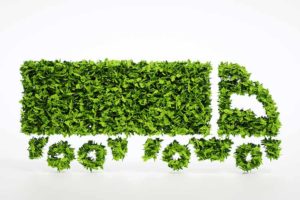However, this also increases the expectations of customers when it comes to the quality of logistics services nowadays. Above all, they want one thing: fast and just in-time deliveries. When customers place their orders online, they expect to have their goods delivered as soon as possible – and they would even pay more for additional services, if only they could cut in half the time normally spend for those goods to arrive.
The cost that our health pays
At the same time, the growth of the logistics industry is causing an overload in the transport infrastructure. The consequences are massive traffic congestions, accidents and overall, high repair costs. Additionally, the increase of the goods transported daily has an impact on the population health.[1] Road traffic causes more CO2 emissions per kilometre than any other type of transport. Road freight transport alone accounts for around 17% of total CO2 emissions worldwide.[2] And if that was not enough, 40% of people in the European Union suffer from traffic noise (> 55 dB).[3]
The consequences are massive traffic congestions, accidents and overall, high repair costs. Additionally, the increase of the goods transported daily has an impact on the population health.[1] Road traffic causes more CO2 emissions per kilometre than any other type of transport. Road freight transport alone accounts for around 17% of total CO2 emissions worldwide.[2] And if that was not enough, 40% of people in the European Union suffer from traffic noise (> 55 dB).[3]
All of this is a direct result of market inefficiencies. About 21% of all transport trips in the EU are carried out empty[4] and approx. 30-50% of the truck load capacities remain unused. .[5]
EU Sustainability Goals
The EU has set ambitious climate and energy targets for their 2020 strategy as sustainability remains a major concern for the European government. For instance, the EU wants to achieve a 20% reduction in greenhouse gas emissions (compared to 1990 levels), 20% of energy use from renewable resources and 20% improvement in energy efficiency.[6]
The reason for hope here is placed with information technology and alternative fuels. Car and truck manufacturers invest in the next generation of autonomous and energy-powered vehicles – witnessing more positive effects than ever before, such as reduced fuel consumption and CO2 emissions, less congestions as well as fewer accidents or injuries.[7]
However, we continue to dream about an idealized version of the future. Autonomous trucks are still under development and all previous attempts to replace petroleum with alternative fuels such as biodiesel, bioethanol, hydrogen, natural gas or liquid petroleum are still in their infancy and in turn, have their own environmental impacts.
The market continues to grow
One reason that precedes all: An increasing number of consumers expect same day delivery on most of the goods they come across online – whether it’s shoes, electronics or furniture. In response, more companies shift their business models to match this demand, by learning how to optimize their supply chain through technology, taking well-established giants like Amazon as an example.[8]
Another reason: the world population is expected to increase to more than 9 billion people by 2050.[9] From the perspective of logistics providers, this means further growth in e-commerce, as the consumer-friendly middle class continues to grow. Even remote rural areas in developing countries have access to the internet. Consequently, as the demand for goods keeps increasing, so is the need to transport those goods.
The consequence: another burden on the transport infrastructure and an ever-increasing environmental pollution.
What can be done?
The industry needs to focus on reducing traffic, CO2 emissions and to achieve the EU sustainability goals. So far, relatively little attention has been paid to freight transport, so the issue of sustainability is still somehow underdeveloped, especially among transport companies.
However, the road freight sector is not one single market, where all customers behave the same. The road freight transport in Europe is highly fragmented. The 10% largest transport companies account together for only 10% of the market share. The transport of goods by road is mainly done by small and medium-sized enterprises (SMEs), of which 90% employ less than 50 people and operate less than 10 trucks.[10]
The fragmented structure of the road freight transport makes it more challenging for the industry to achieve the already set climate goals. The greatest potential for optimization remains in the utilization of transport capacities. For instance, up to 20% (equivalent to 2.6 million tonnes of carbon dioxide) could be saved in this way. However, SMEs lack the necessary IT support for this. They use outdated IT systems that can barely communicate with each other and important data is neither stored nor exchanged between those involved in the process. Manual processes such as the telephone and fax machines are still the basics of communication between some parties involved in transport logistics. If we take as an example the study conducted by TechCrunch, 67% of carriers rely solely on printed documents.[11]
However, we are now witnessing a major shift within the industry, as the rise from offline to online (O2O) is already taking place. The fast development of the digital business infrastructure creates new capabilities and competitive advantages, ready to replace the traditional business models.
Saloodo! the green digital logistics portal
Saloodo! sets new environmental standards in logistics through digitalization. Saloodo! offers shippers the so-called “spot market” – the market for the short-term transport business – as well as instant access to verified carriers through a smart, digital freight platform.
The platform gives carriers the opportunity to optimize their daily processes using high-end technology and provides access to additional transport. This in turn, is the basis for improved truck utilization. In the future, a digital assistant will help calculate the available loading capacity and match it with other transport requirements.
How Saloodo! saves millions of trees and you can do
To improve the heavily paper-based administration processes, we from Saloodo! implemented an online document management system. Documents such as proof of delivery, delivery orders, incoming payments or invoices can be entered and processed online at any time. With an average of 8 paper pages per transport order and approx. 300,000 completed transport transactions in Germany alone, Saloodo! can help save up to 2.4 million sheets of paper per year.
Focus on a greener future
Saloodo! uses technology to reduce the negative environmental impact of the transportation business and has a clear vision on the subject:
Make our customers more profitable and greener at the same time.
“Conserving the environment has never had a higher priority, especially in transport and logistics. We want to contribute, and we know we’re on the right track with our technology,” says Daniel Mahnken, Head of Communcations at Saloodo!.
There is still a lot to do
Despite all the efforts that are made to fundamentally change a business model, the customer remains the focus of digitalization. With technologies that have the potential for such a change, now is the perfect time to put them to good use – and this process has already begun. Join us for a greener future!









